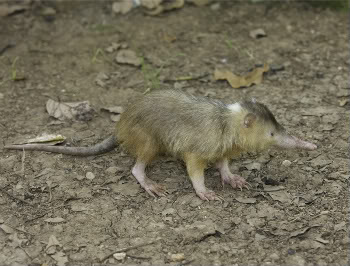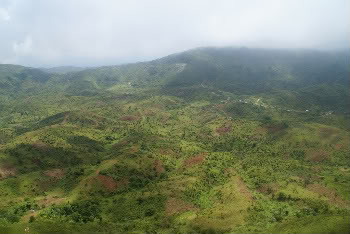First film footage also released of the strange solenodon
In the journal Oryx researchers from EDGE, a program of the Zoological Society of London (ZSL), have announced the rediscovery of a small population of Hispaniolan solenodons in Haiti. At the same time scientists in the Dominican Republic have taken the first ever footage of this endangered mammal.
There are few animals stranger than the Hispaniolan solenodon. The species can perhaps be best described as a plump rat sporting multi-colored fur and the long dangly nose of an elephant shrew. Its eyes are tiny pin-pricks, while its feet have long gnarled toes and nails that appear in desperate need of trimming. Something about the animal makes it look old and cantankerous, like an insectivorous hairy Yoda. But the Hispaniolan solenodon is no flight-of-fancy.
 Hispaniolan solenodon taken in the Dominican Republic. Photo by Gregory Guida, Durrell Wildlife Conservation Trust. |
Dr. Samuel Turvey, a member of the EDGE research team who rediscovered the species in Haiti, says that solenodons “constitute an ancient mammal lineage that diverged from all other living mammals around 76 million years ago, during the time of the dinosaurs”. The Hispaniolan solenodon has only one living relative, the Cuban solenodon, which Turvey describes as “only distantly related”. Both species are often referred to as a ‘living fossils’ since they are essentially a windows into the early mammals of the Cretaceous.
The solenodon is unique in more ways than outward appearance. “They are the only living mammal species that are able to inject venom through specially modified teeth, similar to the way that snakes inject venom – a very unusual adaptation for a mammal!” explains Turvey. While there are other venomous mammals, including two species of shrews and the male duckbill platypus, they are capable of only passively conveying venom; shrews’ venom resides in their saliva and duckbill platypuses possess a poisonous claw on their hind leg.
 Detail of Hispaniolan solenodon head. Photo by Gregory Guida, Durrell Wildlife Conservation Trust. |
In spite of its uniqueness in the animal kingdom, the Hispaniolan solenodon faces great pressure today. Its forest habitat has been invaded by alien predators and degraded by humans, allowing for only pockets of small populations to survive. Before European colonization of Hispaniola—the island which today includes the nations of Haiti and the Dominican Republic—it is believed that the solenodon had no natural predators. It’s slow and clumsy gait, hardly useful for evading predators, is cited as evidence for this. However, once Europeans arrived the island became overrun with dogs, cats, and the Asian mongoose which prey heavily on the island’s endemic species, including the solenodon. In fact, the solenodon is one of the few island mammals to have survived this onslaught.
Hispaniola was “never colonized by true carnivores,” Turvey said, “so solenodons probably represented the top mammalian ‘predators’ of these unusual island ecosystems before human arrival, although they are generalist insectivores rather than really carnivorous.”
 Detail of Hispaniolan solenodon feet and claws. Photo by Gregory Guida, Durrell Wildlife Conservation Trust. |
The appearance of invasive species, compounded by human encroachment and habitat degradation, has pushed the solenodons to the verge of extinction. By the 1990s a couple populations persisted in the Dominican Republic, but Haiti’s only population of solenodons was predicted to have only 10-20 years left before it vanished. While the bleak prognosis was due largely to the amount of pressure on the solenodon, it also reflected the general laxity of the conservation community toward species that don’t have the requisite ‘charisma’ or popularity with the public. It is a trend EDGE is working to overcome.
“So far solenodons have been sorely neglected by conservationists,” Turvey says, “many of whom have probably never even heard of them.”
The survey in Haiti undertaken by Dr. Turvey and colleagues was to ascertain if any solenodons still survive or if the nation had lost one of its natural treasures. In April 2007 the team of scientists spent eleven days in Massif de la Hotte region of Haiti interviewing subsistence farmers and villagers. This mountainous region was the last place where solenodons survived in Haiti; previous researchers outlined an area of solenodon habit in the Massif de la Hotte of only about eight to ten square kilometers.
The survey proved a success. The scientists’ interviews and the subsequent discovery of three dead solenodons—one of which had been eaten by a farmer—confirmed that the solenodon still survives in Haiti. In fact, the researchers believe that the species’ range may be even larger than it was a decade ago. They found evidence that the solenodons occupied lower elevations than expected and could even survive in largely degraded habitat. In the paper announcing their results, the researchers hypothesize that a widespread culling of dogs in the region may have saved the solenodons from extinction and even allowed them to expand their small range.
 Massif de la Hotte region in Haiti from Google Earth.
|
The re-discovery of the Haitian population of solenodons is important for an additional reason. Researchers stress that preservation of solenodon habitat and conservation measures would not only aid the solenodon but other endangered species, including Hispaniola’s only endemic rodent, the hutia, which is classified as vulnerable by the IUCN, as well as the gray-crowned palm-tanager, also endemic to the area. The Massif de la Hotte region may also be ripe for new discoveries: while visiting for only eleven days the researchers made the first sighting of an indigo bunting in Haiti and recorded the island’s first yellow-headed blackbird.
Despite this wealth of biodiversity, conservation in Haiti faces many hurdles. “Haiti is the poorest country in the Western Hemisphere, and obviously the ongoing humanitarian crisis has meant that there have been few national resources available for conservation or environmental work,” Turvey said. “So far there are only a couple of sites in the entire country that have been awarded national protected status. The Massif de la Hotte is home to a large number of unique endemic species restricted to this small mountain region, but although it contains one of Haiti’s few national parks, and has been identified as a globally significant region by the Alliance for Zero Extinction (AZE), there still is little concerted conservation activity even here.”
At the same time as the EDGE team was surveying in Haiti, conservation work concerning solenodons was taking place on the other side of the island in the Dominican Republic.
A large number of organizations—ZSL, the Durrell Wildlife Conservation Trust (DWCT), the Ornithological Society of Hispaniola, the Audubon Society of Haiti, and the Dominican Republic’s National Zoological Park and Agency for Protected Areas and Biodiversity—are currently collaborating to create a program that would conserve Hispaniola’s endemic land mammals, including the solenodon, throughout Haiti and the Dominican Republic.
Richard Young, a conservation biologist with the DWCT who is working on the program, says “the project would enable the long-term conservation of the Hispaniolan solenodon by conducting large scale surveys to assess its population status and a field study in order to identify the main human-driven threats to its survival”.
 Researchers collected a dead solenodon in this area. A few days before a live solenodon had been reported in the same place. Photo by Samuel Turvey. |
A pilot project was conducted by the DWCT and the Ornithological Society of Hispaniola this past summer. Due its scarcity and the general lack o knowledge about the solenodons, Young was surprised by the success the team had in finding solenodons: “during one month of intensive trapping effort one individual was caught in a live-trap, providing a valuable DNA sample and some very rare film footage of the solenodon after the animal was released”.
The DWCT, created by the popular author and honored naturalist Gerald Durrell, focuses much of its attention “on conserving vulnerable communities of endemic animals which make such a valuable contribution to global biodiversity” according to Young. Like EDGE it has a history of working with species and places that haven’t gained the attention of the larger conservation community.
While the solenodon’s future remains precarious, the recent attention from EDGE, DWCT, and other organizations will be vital if the species is to survive.
Now that there has been confirmation of the species in Haiti, a more thorough study of the population needs to be undertaken. “Given the lack of any targeted mammal conservation research in Haiti for almost 2 decades,” the scientists wrote in Oryx, “immediate further investigation is required into solenodon distribution, habitat utilization, density, and interaction with introduced predators across the region”. Until such a major project begins, community-based endeavors such as local surveys and the general raising of awareness (because of its scarcity the species is unknown even to many Haitians) is currently underway.
 Hispaniolan solenodon. Photo by Gregory Guida, Durrell Wildlife Conservation Trust. |
While the immediate future of the project in the Dominican Republic is focusing on fundraising, Young hopes the project will begin in 2009. The long-term goal of the project is to establish a species action plan that “would set out the main actions needed to conserve the species, and develop an island-wide monitoring programme to understand if future conservation efforts are effective.
A final mystery remains. In 2001 biologist Jose Alberto Ottenwalder suggested that the solenodons of Haiti may be distinct enough from those in the Dominican Republic to represent a subspecies; Ottenwalder went ahead and named it Solenodon paradoxus woodi . Others have even suggested the solenodons in Haiti could be a distinct species, providing even more urgency for the conservation of the Haitian population. Further studies should provide the answer to the level of relation between the populations.
Such debate is not new to solenodons. The taxonomy between the Hispaniolan and the Cuban solenodon is under discussion: some believe they should not share the same genus since the two species are separated by an astounding 25 million years.
 Another view of Hispaniolan solenodon habitat. Photo by Samuel Turvey. |
When asked about their hope for the future of the solenodon both Turvey and Young proved cautiously optimistic.
Noting their extreme scarcity and the number of threats they face, Turvey sees hope in the mammal’s ability to survive: “solenodons seem to be tenacious little animals in many ways, as they have somehow managed to survive in the West Indies when over 100 other land mammal species have died out in the region as a result of human activities.”
Young says that the species has a chance “given some good conservation science and planning and if effective partnerships between national and international partners can be built, conserving this species is possible but actions are needed urgently.”
Both scientists agree that without active conservation the solenodon will likely go extinct. There is little doubt that if this is allowed to happen, the world will suffer the loss of one of its most unique inhabitants.
Samuel T. Turvey; Helen M.R. Meredith; R. Paul Scofield. Continued survival of Hispaniolan solenodon Solenodon paradoxus in Haiti. ORYX October 2008.
For footage of the Hispaniolan solenodon please see the EDGE blog: http://www.edgeofexistence.org/edgeblog/?p=761















